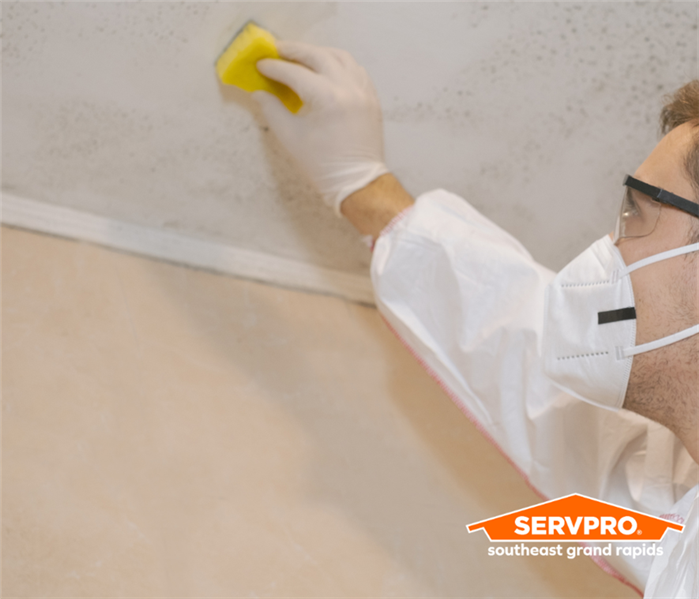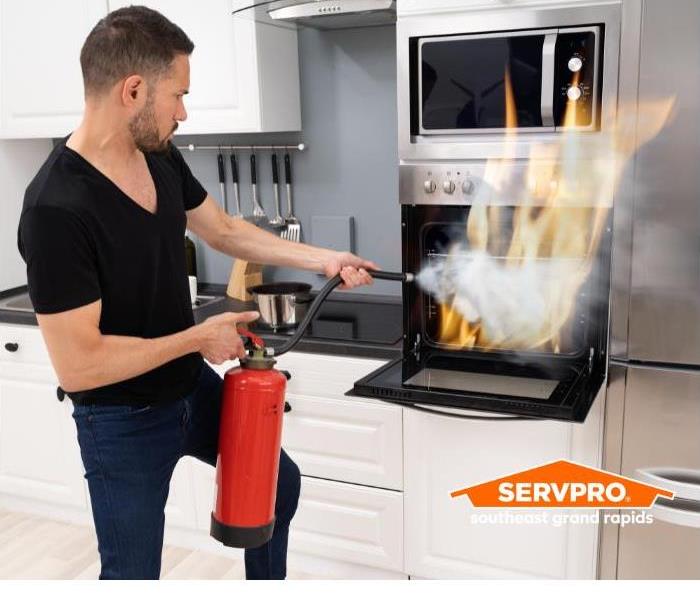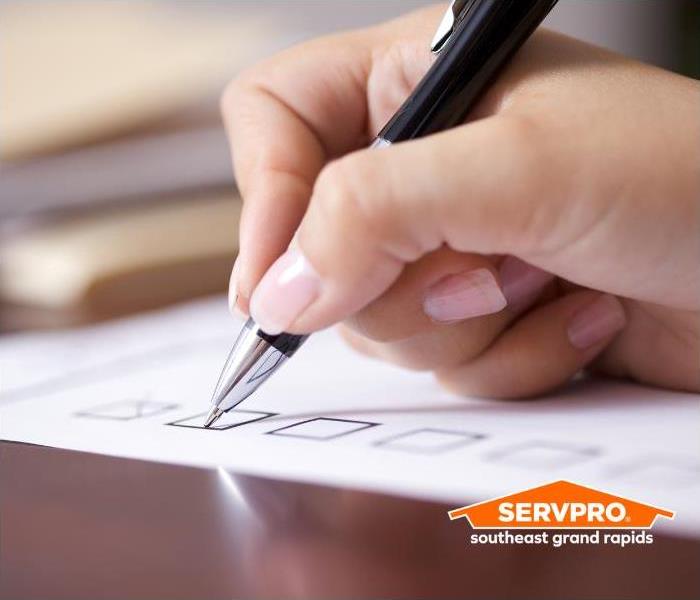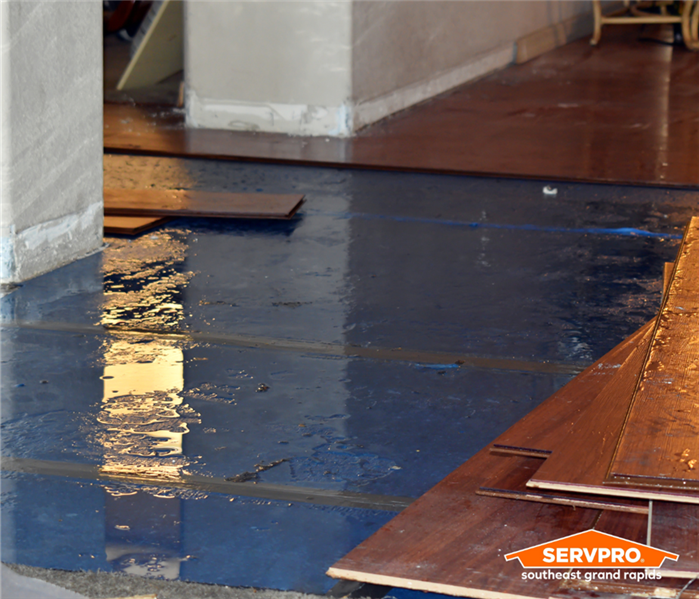Recent Posts
How Winter Weather Can Lead to Water Damage
11/11/2024 (Permalink)
Winter in Southeast Grand Rapids brings beautiful snowy landscapes, but it can also create unique challenges for home and business owners. Snow buildup, ice dams, and melting snow are common culprits that can lead to significant water damage if not properly managed. Here’s a closer look at these winter-related issues and tips to protect your property.
1. Snow Buildup on Roofs As snow accumulates on rooftops, it adds substantial weight and creates the potential for water infiltration. If there are any weak points or small cracks in the roof, the melting snow can seep into the building, damaging insulation, ceilings, walls, and more. Keeping your roof clear of excessive snow is essential to prevent structural stress and potential leaks.
2. Ice Dams Ice dams occur when snow on the roof melts, runs down, and refreezes along the eaves, forming a barrier that traps additional melting snow. As water builds up behind the ice dam, it can seep under shingles and enter the home, causing damage to walls, ceilings, and insulation. Proper attic insulation and ventilation can help reduce the likelihood of ice dams by keeping the roof’s surface temperature consistent.
3. Melting Snow Near Foundations When temperatures fluctuate, melting snow around a building’s foundation can lead to water infiltration, especially if the ground is still frozen and unable to absorb moisture effectively. The excess water can seep into basements or crawl spaces, causing mold growth and structural damage. To avoid this, clear snow away from the foundation and ensure gutters and downspouts direct water well away from the building.
By taking preventive measures, you can protect your property from winter’s potential hazards. However, if water damage does occur, SERVPRO® of Southeast Grand Rapids is Here to Help™. Our team specializes in water damage restoration to bring your home or business back to pre-damage condition. Don’t let winter weather catch you off guard—stay proactive and prepared!
Preventing Frozen Pipes: Essential Tips for Homeowners
11/4/2024 (Permalink)
As temperatures drop in West Michigan, the risk of frozen pipes increases—a problem that can lead to significant water damage if not prevented. Frozen pipes are more than just an inconvenience; they can burst, causing costly damage and leaving you with a flooded home. Here’s why pipes freeze, the dangers they present, and practical steps you can take to protect your home.
Why Do Pipes Freeze?
Pipes are at risk of freezing when temperatures fall below 32°F (0°C). As water freezes inside pipes, it expands, creating intense pressure. Pipes located in unheated or poorly insulated areas, like basements, attics, and crawl spaces, are especially vulnerable. Even a slight drop in temperature can lead to freezing in these areas.
Damage Caused by Frozen Pipes
Frozen pipes can burst, leading to significant flooding and water damage. In addition to costly repairs to plumbing and waterlogged areas, water damage can lead to mold growth, affecting your home’s air quality and potentially causing health issues. Preventing frozen pipes is essential to avoiding this costly and damaging scenario.
Tips for Preventing Frozen Pipes
Insulate Exposed Pipes: Wrap pipes in unheated areas with foam insulation sleeves. This simple step can help maintain the temperature around the pipes and reduce the risk of freezing.
Seal Gaps and Cracks: Look for gaps around windows, doors, and walls, especially near pipes, and seal them to prevent cold air from getting inside. Caulking and weather stripping can be effective barriers against drafts.
Let Faucets Drip: On extremely cold nights, let faucets connected to exposed pipes drip slightly. The movement of water through the pipes can prevent freezing.
Keep the Heat On: If you plan to be away, keep your thermostat set to at least 55°F. Maintaining a steady temperature helps prevent pipes from reaching freezing levels.
Open Cabinet Doors: In bathrooms and kitchens, open cabinet doors to allow warm air to circulate around pipes, especially if they’re near outside walls.
By taking these proactive steps, you can protect your home from the damage and expense of burst pipes. At SERVPRO Southeast Grand Rapids, we understand how devastating water damage can be. If you ever face issues with frozen or burst pipes, our team is Here to Help™ with prompt, professional service to restore your home. Stay safe and warm this winter!
Why Winter Flooding is More Common Than You Think
11/4/2024 (Permalink)
When we think of winter hazards, flooding might not be the first thing that comes to mind. Yet, winter flooding is more common than you’d expect, especially here in Southeast Grand Rapids. The cold weather can create unique conditions that increase the risk of flooding around homes and businesses. Let’s explore some surprising causes of winter flooding and offer practical tips to help you stay prepared.
1. Snowmelt
As snow accumulates through the winter, it might seem harmless. However, when temperatures suddenly rise, all that snow can melt rapidly, overwhelming drainage systems. This snowmelt creates large volumes of water that can seep into basements or create pooling around your foundation, increasing the risk of interior flooding.
Tip: Keep an eye on the weather, especially when temperatures are expected to rise after a heavy snowfall. Clear snow away from your foundation to help reduce water saturation around your home.
2. Blocked Drainage
Ice and debris can block storm drains, gutters, and downspouts, preventing water from flowing away from your property. Blockages cause water to back up, often resulting in leaks or water pooling around the foundation.
Tip: Regularly check and clear your gutters, downspouts, and nearby storm drains. If water starts pooling, take steps to redirect it away from your home.
3. Rain-on-Snow Events
Rain during winter might seem rare, but when it happens, it can be especially problematic. Rainfall on top of snow cover creates an immediate risk of flooding. The rain speeds up snowmelt and adds extra water, which can quickly lead to overflow around homes.
Tip: Be prepared with a sump pump and consider adding sandbags in low-lying areas. Keep an emergency kit handy with supplies to manage unexpected leaks or flooding.
Stay Prepared This Winter
Winter flooding can cause significant damage if left unchecked, but with a few preventive steps, you can reduce your risk. By staying aware of winter weather patterns and preparing your home in advance, you can help protect your property and peace of mind. If winter flooding does occur, SERVPRO® of Southeast Grand Rapids is here 24/7 to help with expert cleanup and restoration.
5 Signs of Mold in Your Home After Winter
11/4/2024 (Permalink)
As winter fades and spring arrives, it’s important to check your home for signs of mold. Winter can create ideal conditions for mold growth—melting snow, high humidity, and poor ventilation all contribute to moisture buildup in your home. When left unchecked, this moisture can quickly turn into a mold problem, which poses health risks and damages your property. Here are five key signs of mold to watch for this spring and tips on what to do if you spot them.
Musty Odors
One of the earliest signs of mold growth is a persistent musty smell. If you notice an earthy or sour odor in certain areas of your home, especially in basements, attics, or crawl spaces, it’s likely mold may be present. Mold produces volatile organic compounds (VOCs) as it grows, which contribute to that unmistakable musty smell.
Visible Spots on Walls or Ceilings
Mold often appears as black, green, or brown spots on walls, ceilings, or in damp areas like bathrooms and basements. During winter, moisture can seep into small cracks or accumulate in unventilated areas, leading to these visible signs of mold by spring. Regularly inspect walls and ceilings in areas prone to moisture buildup.
Water Stains or Peeling Paint
Condensation on windows or water stains on walls can indicate underlying moisture problems that may lead to mold growth. Similarly, peeling or bubbling paint is a common sign of moisture damage. Mold thrives in damp, warm conditions, so any signs of moisture accumulation warrant close inspection for mold growth.
Increased Allergy Symptoms
If you or your family experience increased allergy symptoms—like sneezing, runny nose, itchy eyes, or respiratory issues—mold might be present. Mold spores can cause these symptoms, especially in individuals with mold sensitivity. Monitor your health and be on the lookout for signs of mold if allergies persist.
Warped or Buckled Flooring
Excess moisture from snowmelt or condensation can lead to warping or buckling in wood or laminate flooring. If you notice changes in your flooring after winter, it may be a sign of hidden mold growth beneath. Addressing warped flooring quickly can prevent further mold damage and structural issues.
If you find mold in your home, take action right away, call SERVPRO® of Southeast Grand Rapids. Our team specializes in mold removal and has the expertise to safely restore your home.
By staying vigilant and addressing moisture issues early, you can keep your home mold-free as winter gives way to spring. SERVPRO of Southeast Grand Rapids is here to help with any questions or remediation needs you may have—because a healthy home is a happy home!
Keeping Family Dinner Safe: Fire Prevention Tips from SERVPRO of Southeast Grand Rapids
9/11/2024 (Permalink)
Family dinners are a cherished time to gather and create memories, but they also come with potential risks. Cooking fires are a leading cause of home fires and injuries, particularly during busy meal times. At SERVPRO® of Southeast Grand Rapids, we want to help you keep your gatherings safe by offering some essential tips for fire prevention and safety.
Dangers of Family Dinner Gatherings
When preparing meals, especially large ones, it’s easy to get distracted by the excitement of family conversations or multitasking. This distraction can lead to unattended cooking and an increased risk of fire. Common causes include overheating oil, burning food, or leaving the kitchen for extended periods.
Tips to Prevent Cooking Fires
Stay Attentive: Never leave cooking food unattended. Stay in the kitchen and keep an eye on what’s cooking. If you need to step away, ask someone else to keep watch.
Keep Flammable Items Away: Ensure that kitchen towels, paper, and other flammable materials are kept away from the stove and oven. These can easily catch fire if they come into contact with hot surfaces.
Use a Timer: Set a timer to remind you when your food is ready, especially for dishes that need to be monitored closely. This helps prevent overcooking and potential fires.
Clean Up: Regularly clean your stovetop, oven, and vents to prevent grease buildup. Grease is highly flammable and can easily ignite if not kept in check.
Check Equipment: Ensure that all kitchen appliances are in good working order. Faulty equipment can pose a fire hazard, so address any issues promptly.
Safety Protocols in the Event of a Fire
Know How to Use a Fire Extinguisher: Make sure you have a fire extinguisher in your kitchen and know how to use it. For small grease fires, use a Class K extinguisher or cover the pan with a metal lid to smother the flames.
Have an Escape Plan: Establish and practice an escape plan with your family. Ensure everyone knows how to exit the house quickly and safely if a fire occurs.
Call for Help: If a fire gets out of control, evacuate immediately and call 911. Never attempt to fight a large fire yourself.
Install Smoke Alarms: Ensure smoke alarms are installed and functioning in your kitchen and throughout your home. Test them regularly and replace batteries as needed.
By following these safety tips and protocols, you can help ensure that your family dinners remain enjoyable and free from the dangers of cooking fires. At SERVPRO, we're committed to helping you protect your home and loved ones. If you do experience a fire, we're here to assist with restoration and recovery to get your life back on track. Stay safe and enjoy your meals with peace of mind!
Creating an Emergency Communication Plan: A Guide for Businesses in Southeast Grand Rapids
9/4/2024 (Permalink)
Emergencies like storms, flooding, and fires can strike without warning, disrupting business operations and potentially causing significant damage. For businesses in Ada, Kentwood, Grand Rapids, and East Grand Rapids, having a robust emergency communication plan is crucial to ensure safety, minimize downtime, and recover swiftly.
What is an Emergency Communication Plan?
An emergency communication plan outlines the procedures and channels your business will use to communicate before, during, and after an emergency. This plan helps ensure that everyone—employees, customers, and stakeholders—receives timely and accurate information, which is essential for maintaining order and safety.
Steps to Create Your Emergency Communication Plan
Assess Your Risks: Identify the specific risks your business faces. In Southeast Grand Rapids, you might be concerned about severe storms, flooding from heavy rains, or fires caused by electrical issues. Understanding these risks helps tailor your plan to address the most pressing concerns.
Establish Communication Channels: Decide how you will disseminate information. This could include phone trees, emails, text messages, or social media updates. Ensure that these channels are reliable and accessible to all employees.
Designate Key Contacts: Assign roles and responsibilities for managing communication. This should include a primary contact person for each type of emergency and backup contacts in case the primary person is unavailable.
Create Message Templates: Develop pre-written messages for different types of emergencies. These templates should be clear and concise, providing essential information such as safety instructions, evacuation procedures, and status updates.
Train Your Team: Regularly train your employees on the communication plan. They should know how to receive and relay information and understand their roles in an emergency situation.
Test and Review: Periodically test your communication plan through drills and simulations. Review the plan regularly to incorporate new risks or changes in your business operations.
Local Considerations
For businesses in Ada, Kentwood, Grand Rapids, and East Grand Rapids, it’s important to consider local resources and emergency services. Familiarize yourself with the contact information for local fire departments, police, and emergency management agencies. Collaborate with these entities to ensure your plan aligns with community protocols and resources.
By having a well-defined emergency communication plan, your business can navigate emergencies more effectively, protect your employees, and maintain operations as smoothly as possible. At SERVPRO of Southeast Grand Rapids, we’re here to help you prepare for and recover from disasters, ensuring your business can withstand any storm, flood, or fire.
Stay Safe and Prepared
Preparation is key to resilience. Invest the time and effort now to create a comprehensive emergency communication plan. Your future self—and your business—will thank you.
Call SERVPRO® at any time if you are experiencing an emergency due to storms, fire, water or a biohazard. We are here 24/7 to help at 616-977-9800.
SERVPRO of Southeast Grand Rapids is a BBB Accredited Business
9/4/2024 (Permalink)
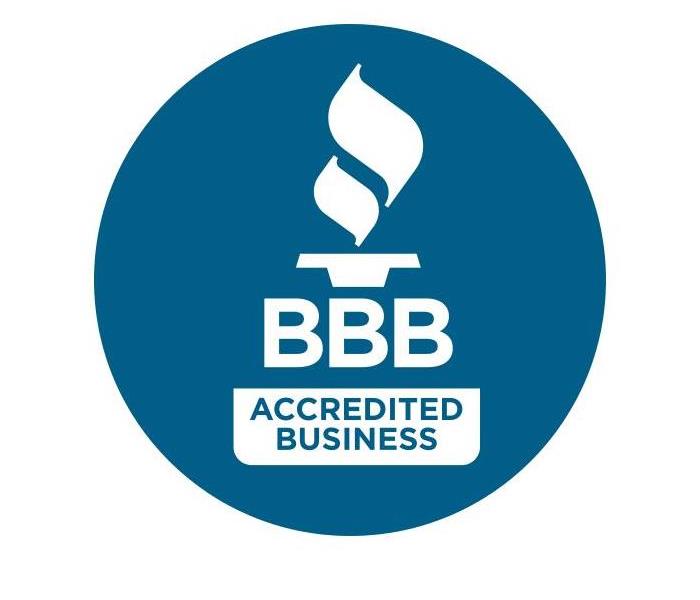 Proud Accredited Business with the Better Business Bureau
Proud Accredited Business with the Better Business Bureau
SERVPRO of Southeast Grand Rapids is proud to be an Accredited BBB Business, serving West Michigan when the unexpected water, fire, storm damage and clean up occurs.
"BBB respects the resiliency of small businesses. Trust has never been more important, and BBB is committed to providing support for small businesses." - BBB Website
We are pleased to be affiliated with the BBB, and appreciate the partnership and the resources they offer to the business community in West Michigan.
Check out the information for SERVPRO of Southeast Grand Rapids at the link below.
https://www.bbb.org/us/mi/grand-rapids/profile/fire-water-damage-restoration/SERVPRO-of-southeast-grand-rapids-0372-38320648
Stay Safe This Fall: Fire Prevention Tips from SERVPRO®
8/28/2024 (Permalink)
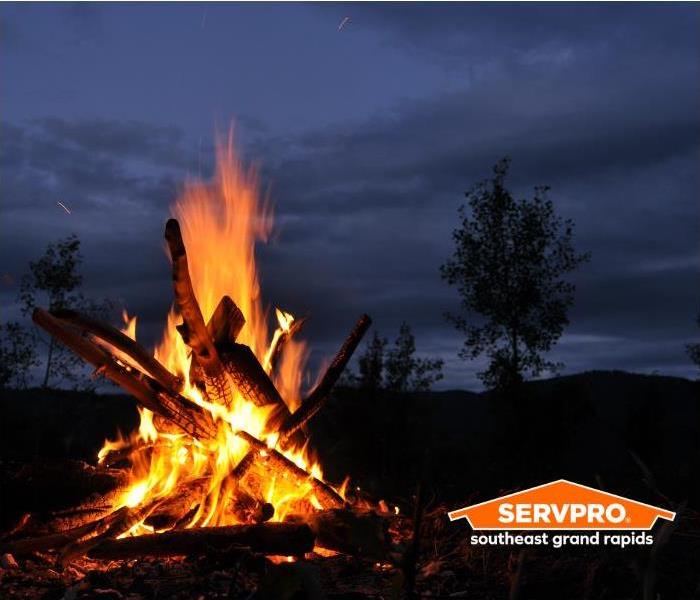
As the crisp fall air settles in and Halloween approaches, it’s essential to keep fire safety top of mind. At SERVPRO®, we’re dedicated to helping our communities stay safe and fire-free. Here are some key tips to ensure your home remains protected this autumn.
1. Be Cautious with Cornstalk Decorations
Cornstalks and hay bales are popular fall decorations, but they can be highly flammable. Keep them away from open flames, candles, and heat sources. Opt for flame-resistant decorations or ensure that any decorations you use are placed at a safe distance from potential fire hazards.
2. Choose Safe Halloween Costumes
Halloween costumes can be a fire hazard, especially those made from flammable materials. Ensure that costumes are made from flame-resistant fabrics. Remind children to stay away from open flames and candles while trick-or-treating.
3. Opt for Battery-Operated Candles
Instead of traditional candles, which pose a fire risk, consider using flashlights or battery-operated candles. These alternatives are much safer and can still provide the festive ambiance without the danger of open flames.
Serving Our Communities
Our commitment to fire safety extends to all the communities we serve, including Forest Hills, Ada, Caledonia, Cascade, Dutton, Kentwood, and Grand Rapids. By following these simple fire safety tips, you can help prevent accidents and keep your home safe.
If you do experience any fire-related incidents, remember that SERVPRO is Here to Help® with expert restoration services. Stay safe this fall, and let’s keep our communities fire-free together!
For more information on fire safety or restoration services, visit our website or contact us today at 616-977-9800.
SERVPRO of Southeast Grand Rapids participates in the National Night Out
8/7/2024 (Permalink)
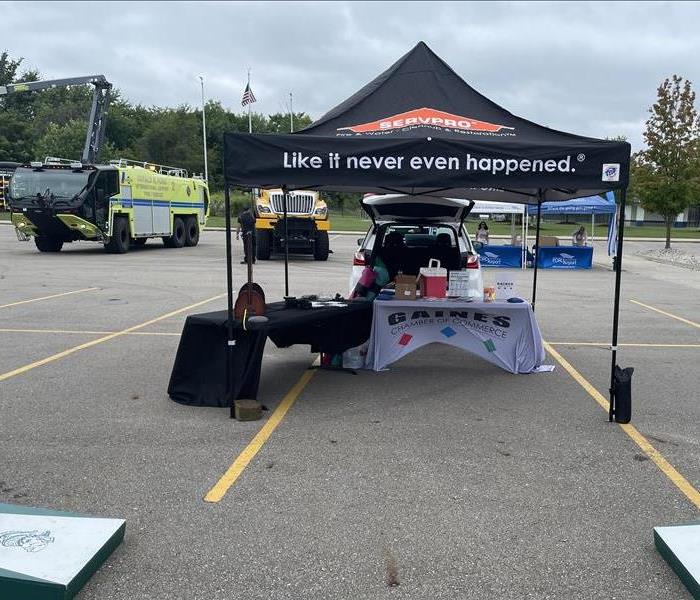 SERVPRO of Southeast Grand Rapids at the National Night Out at South Christian High School in Byron Center Michigan
SERVPRO of Southeast Grand Rapids at the National Night Out at South Christian High School in Byron Center Michigan
SERVPRO of Southeast Grand Rapids participated in the National Night Out event at South Christian High School, organized by the Kent County Sheriff's Department. Several police, fire, and safety organizations also took part in the event. The participating agencies included the Kent County Sheriff's Department, Kent County Public Safety, Gerald R. Ford Airport, Davenport University, Cutlerville Fire Department, Dutton Fire Department, Caledonia Fire Department, Michigan State Police, Michigan Department of Natural Resources, SERVPRO of Southeast Grand Rapids, the Gaines Township Chamber of Commerce, and several other non-profits, companies, and organizations. Thank you to the men and women of our police and fire departments for serving and protecting our community.
Restoring Your Commercial Property After Water Damage: Trust SERVPRO® of Southeast Grand Rapids
7/31/2024 (Permalink)
Water damage can strike at any time, causing disruption and potential hazards for your commercial property. At SERVPRO® of Southeast Grand Rapids, we understand the urgency of restoring your business to its pre-damage condition. Here’s why you can rely on us for effective and responsible restoration services.
Expert Restoration with a Focus on Compliance
Our team of professionals is highly trained to handle water damage restoration with meticulous care, being mindful of legal and environmental regulations. We work quickly to assess the situation and come up with an action plan that gets you back up and running as soon as possible.
24/7 Emergency Services
Water damage doesn’t adhere to business hours, and neither do we. SERVPRO® of Southeast Grand Rapids offers emergency services 24/7, ensuring that we’re always available to address your needs promptly and efficiently. Our quick response helps minimize downtime and prevent further damage to your property.
Serving Our Communities
We proudly serve a broad range of communities, including Ada, Caledonia, Cascade, Kentwood, Grand Rapids, East Grand Rapids, Dutton, and Forest Hills. No matter where you are, our skilled team is ready to provide top-notch restoration services tailored to your specific needs.
If your commercial property faces water damage, don’t hesitate to contact SERVPRO® of Southeast Grand Rapids. We’re here to help you navigate the restoration process smoothly and efficiently, so you can get back to business as usual.






 24/7 Emergency Service
24/7 Emergency Service


